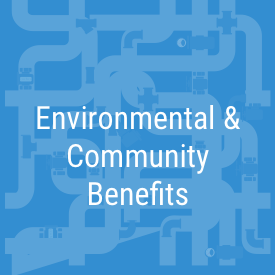This project provides flood protection to thousands of homes and businesses in Mountain View and Los Altos, created recreational opportunities and enhanced the environment. The project spanned 10.6 miles of Permanente Creek, from San Francisco Bay’s southwest shoreline through Mountain View to Foothill Expressway in Los Altos. A natural flood protection approach to prevent potential flooding damages in excess of $48 million (1999 value) was used for many of the key project elements. The project includes multiple elements: channel improvements; flood detention area and recreational improvements at City of Mountain View’s McKelvey Park; and flood detention areas, recreational improvements and enhanced habitat at County of Santa Clara’s Rancho San Antonio Park.
*This project was funded by the voter-approved 2012 Safe, Clean Water and Natural Flood Protection Program








Permanente Creek Flood Protection Project (completed)
This project was completed with funding from the voter-approved 2012 Safe, Clean Water Program and included four flood protection elements at different parts of Permanente Creek. See below for specific information about the flood detention basins at the county's Rancho San Antonio Park and Mountain View's McKelvey Park and the channel improvements elements.
Flood Insurance Rate Map Update
The Flood Insurance Rate Map (FIRM) for the Permanente Creek watershed Valley has been updated from its headwaters to the bay to reflect the Permanente Creek Flood Protection Project constructed by Valley Water. The new FIRM will be effective September 5, 2024, assuming no appeals to the maps are filed before then. FEMA approved changes to flood maps when it approved a Letter of Map Revision (LOMR) application submitted jointly by Valley Water, the City of Mountain View, the City of Los Altos, the City of Cupertino and Santa Clara County.
The revised maps and FEMA’s approval letter are available online from the Federal Emergency Management Agency’s (FEMA) map service center at www.msc.fema.gov as “pending Products” as of April 24, 2024.
The LOMR maps many properties into a lower risk zone, changing the flood zone from a FEMA 100-year floodplain Zone A (e.g., Zone AE, AH, AO) to a FEMA zone with lower flooding risk (e.g., Zone X). Properties within the 100-year FEMA floodplain have a 1% annual chance of flooding to one foot or greater depth. Properties within FEMA’s 100-year floodplain which are currently required (prior to September 5, 2024) to hold a flood insurance policy per the Flood Disaster Act of 1973 and the National Flood Insurance Reform Act of 1994, will be remapped into a lower risk zone after the LOMR is approved and may be able to waive that requirement.
If your property is eligible for waiving the flood insurance policy requirement, FEMA and Valley Water suggest you still consider the voluntary purchase of flood insurance because high-risk areas are not the only dangers of flooding. Regardless of your risk level, you might consider contacting your insurance provider to discuss flood insurance options for your property under the new flood designation. If your property has a mandatory insurance requirement that you wish to reconsider, the following information may be helpful for understanding that process.
Starting the insurance removal process
Each lender may have different requirements for property owners to obtain a waiver from the requirement to hold a flood insurance policy after their property has been remapped from a 100-year FEMA flood zone to a lower risk Zone X.
The following are suggested actions you can take to help you get started with your lender process:
Confirm that your building has been placed in Zone X.
a. Use the map link to see if your property zoning has changed.
b. If your property is in Zone X, print (or download) a copy of the map showing your property’s address. Although not an official FEMA document, this document may help your lender quickly see that your property has been removed from the FEMA 100-year floodplain.
Gather basic documents as your lender will likely request documentation stating the change.
a. Obtain a copy of the official FEMA LOMR document. Currently, only the final draft map documents are available (see links below); after September 5, 2024, the final documents will be available if no appeals are filed. Click on the links below to download and print a copy.
Santa Clara County (Unincorporated Areas)
b. Print a copy of the letter you received from Valley Water informing you of FEMA’s LOMR approval.
c. Include the map from step one.
Call your lender, inform them of the new flood zone designation and discuss the documents that support your request. Ask if other documents are needed.
Send your lender the materials requested to obtain a waiver from the requirement to hold flood insurance.
If you purchased insurance from an insurance agent:
When you receive the waiver letter from your lender, contact your insurance agent and ask to have the policy canceled. Being removed from a high-risk flood zone doesn’t mean your property has no flood risk. It’s best to maintain coverage to protect your home or business.
If your lender purchased the flood insurance policy for you and billed you for it:
Ask your lender to cancel the policy and change the rates to reflect the reduced flooding risk at your property.
Your insurance agent or lender will determine what refund standards apply to your policy, if any.
Valley Water does not advise people to cancel their flood insurance as flooding risks still exist.
Additional Contact Information
If you have questions about FEMA mapping or insurance, you can contact the FEMA Mapping and Insurance Exchange (FMIX) by phone at 1-877-336-2627, email [email protected], or live chat.
May 2024
Project Fact Sheet and Inserts
- Permanente Creek Fact Sheet
- Channel Improvements and Floodwalls Insert
- McKelvey Park Insert
- Rancho San Antonio Insert
- Public Outreach Summary Insert
- Project Milestones Timeline
Final Subsequent Environmental Impact Report (November 2012)
Addendums to the Final Subsequent Environmental Impact Report
- Addendum to the Final SEIR (May 2013)
- Second Addendum to the Final SEIR (September 2016)
- Third Addendum to Final SEIR (May 2017)
- Fourth Addendum to the Final SEIR (June 2018)
- Fifth Addendum to the Final SEIR (February 2020)
- Sixth Addendum to Final SEIR (December 2020)
Aerial Project Video
Valley Water developed a video of the completed Permanente Creek Flood Protection Project with aerial images of all the project elements. Click here to see the video.
Rancho San Antonio Detention Basin (completed)
This detention basin element was completed in June 2021. Valley Water held a zoom event to celebrate the completion of the civil construction of the Rancho San Antonio Detention Basin, the last element of the Project. To view the event video or the aerial video of the 10-mile stretch of the project, visit the project page.
McKelvey Park Detention Basin (completed)
This detention basin element was completed in February 2020. View more information about this completed project element.
Channel Improvements Elements: Levees/Floodwalls and Channel widening elements (completed)
The construction of these elements was completed in December 2018. View more information about these completed project elements.
Video from the 2017 groundbreaking event
Key Performance Indicator for the Safe, Clean Water Program
-
Provide flood protection to 1,664 parcels downstream of El Camino Real, including Middlefield Road and Central Expressway.
Benefits
-
Provides flood protection to a minimum of 1,664 parcels (1,378 homes, 160 businesses and 4 schools/institutions) downstream of El Camino Real from a 1% (or 100-year) flood
-
Prevent flooding of Middlefield Road and Central Expressway
-
Minimize the future cost for maintenance
-
Provide opportunities for environmental enhancements and trail extension
Geographic Area of Benefit
Mountain View and Los Altos
Flooding History and Project Background
Permanente Creek has a history of flooding, having experienced major flooding in 1862, 1911, 1940, 1950, 1952, 1955, 1958, 1963, 1968, 1995 and 1998. Flooding can result in millions of dollars in damage to homes, businesses and schools. In addition, disruption to businesses and transportation networks can result in significant loss of productivity and revenue. One of the project’s goals is to avoid utility and transportation shutdowns and prevent potential damages that could exceed $48 million (1999 value).
Each winter, thousands of households, schools and businesses in Mountain View and Los Altos are susceptible to flooding from Permanente Creek during a major storm. The Santa Clara Valley Water District has initiated planning of a flood-protection project along 10.6 miles of Permanente Creek, from San Francisco Bay’s southwest shoreline through Mountain View to Foothill Expressway in Los Altos.
The Permanente Creek Flood Protection Project offers a tremendous opportunity for a multi-purpose project to improve flood protection, create recreational opportunities and enhance the environment. The District worked with the cities and the community to design the most suitable alternative.
About the Safe, Clean Water and Natural Flood Protection Program
In November 2012 the voters of Santa Clara County overwhelmingly approved Measure B, the Safe, Clean Water and Natural Flood Protection Program, as a countywide special parcel tax for 15 years with a sunset date of June 30, 2028. This Program replaced the Clean, Safe Creeks and Natural Flood Protection Plan, which voters approved in November 2000.
The Safe, Clean Water Program was developed with input from more than 16,000 residents and stakeholders and was created to match the community’s needs and values. The voters of Santa Clara County identified five priorities:
Priority A: Ensure a Safe, Reliable Water Supply
Priority B: Reduce Toxins, Hazards and Contaminants in our Waterways
Priority C: Protect our Water Supply from Earthquakes and Natural Disasters
Priority D: Restore Wildlife Habitat and Provide Open Space
Priority E: Provide Flood Protection to Homes, Businesses, Schools and Highways
Other: Six projects from the Clean, Safe, Creeks Plan have been carried forward into the Safe, Clean Water Program.
Each year, Valley Water prepares a report providing a progress update for each of these Program priorities, along with fiscal year accomplishments.
To ensure transparency and accountability to the voters, the ballot measure also created an Independent Monitoring Committee, appointed by the Santa Clara Valley Water District Board of Directors. The Independent Monitoring Committee annually reviews the Program’s progress to ensure the outcomes are achieved in a cost-efficient manner and reports its findings to the Board.
In addition, the Program requires three independent audits, the first of which was conducted in FY 2017.





